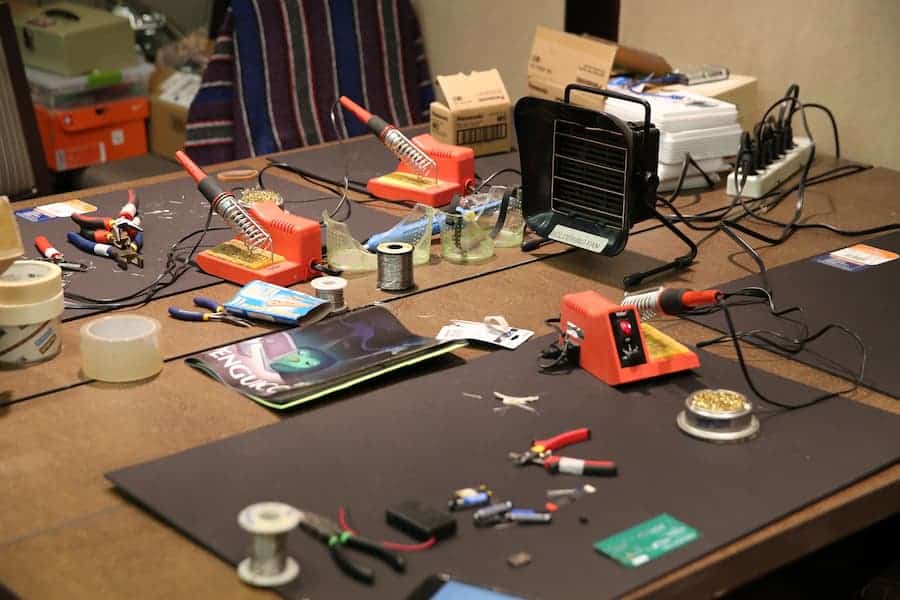Many lawn mowers are battery-operated, and keeping them charged can be a bother. As an alternative, gas powered lawn mowers need gas on hand. Both have their drawbacks, and aren’t great for the environment.
We have put together a guide on how to build a solar charged remote control lawn mower. This project helps you reduce your carbon footprint while also saving money on your electricity bills.
Advantages of Using a Solar Remote Control Lawn Mower
A solar-powered lawn mower is a great solution to keep your lawn looking excellent, while maximizing convenience without incurring additional costs (excluding the initial investment).
Small lawns will benefit the most from this setup, as the remote controlled mower will be able to quickly cut your grass for you. Other benefits include:
- Your lawnmower will not require any additional oil or gas to trim the grass on your lawn. You’ll save a lot of money on frequent fill-ups this way.
- A solar-powered lawn mower is better for your personal health. There will be no more dangerous discharges or gas smells. This is better for you, and better for your children (if you’ve convinced them to help you with mowing the lawn).
- The sun is a free source of energy that is available 365 days a year to any environmentally conscientious user.
Cheap lawn mowers typically are gas or battery powered. These lawn mowers are usually under $300, and are not great for the environment. Even the best corded electric lawn mower has its environmental drawbacks.
Larger lawn mowers that you ride have conventional engines that rival small cars. For mowing hills, a riding lawn mower is great, but is also a gas guzzler. Riding mowers are also great for tall grass, but again require a lot of fuel and take time to mow.
How to Build a Solar Charged Remote Control Lawn Mower
When building a solar-charged remote control lawn mower, you need a solar panel, a rechargeable battery, a stainless steel blade, a direct current (D.C) motor, and a control switch. The D.C motor drives the lawn mower blade, and you should link it to the motor’s shaft.
It’s best to control the solar lawn mower using a switch on the board that closes the circuit and allows electricity to pass to the motor, which drives the mowing blade. The solar charging controller recharges the battery.
To make a solar-charged remote control lawn mower, install solar panels on the mower and leave it placed in the sun to charge. These steps will guide you on how you on how to build your mower.
Step 1: Tools and Materials Needed
To build a solar lawn mower, you’ll need first to gather the correct tools and materials. Pick high quality materials, as you don’t want to put in all this effort only for something to break quickly.
Tools
- Wire stripper
- Wrenches
- A screwdriver
- A voltage meter
- Iron for soldering

Materials
- A battery-powered lawn mower
- Two twelve-volt photovoltaic solar panels
- Four general-purpose rectifier diodes
- A double-stick tape
- Bolt, washers, and nuts
- A solder
Step 2: Assess the Lawn Mower’s Current Condition
After you’ve double-checked that you have all of the tools and materials you’ll need for your solar lawn mower, you need to review the batteries in the lawn mower. They need to be working to start with.
If they’re dead, you’ll need to make (or buy) a new battery pack. You can purchase at least four replacement batteries from your local electrical supply store. Apply double-stick tape between each battery to keep them together, just like the original setup.
Bonus: Read up on our recommendations for the best lawn tractor batteries.
Step 3: Wire a Diode
We measure the power output of a photovoltaic (PV) solar cell in watts. When the sun shines, the PV cell’s potential exceeds that of the batteries, allowing energy to flow from the PV cells to the batteries.
When the sun goes down, electricity will start flowing in the opposite direction from the batteries to the PV cells, unless you take action to prevent it. The heat from the PV cells will waste this energy, eventually burning them out and emptying the batteries.
You can avoid this by using diodes in the circuit. A diode is similar to an electrical one-way check valve. It allows the solar panel to charge the battery while preventing the battery from heating the solar panel.
Step 4: Hook Up the Batteries
We are back to the battery pack now. Consider these four batteries to be two sets of two. Connect them and check the voltage to make sure they are both at 12 volts. The open-circuit voltage (OCV) could be in the range of 14 volts.
This range is very normal. If it’s less than 10 volts, it could be a faulty battery.
Finally, we will make a connection between the two battery sets. To connect our PV cells, first strip the wire, and then wire together. Make sure not to cut through the wire as you strip the insulation.
Step 5: Install the Power Taps
Breach the positive voltage lead and insert a diode, just as we did with the connector. Ensure that the diode’s band is nearest to the red wire.
Step 6: Repeat the Process
Repeat the process on the other side. Ensure that the diode’s band is pointing away from the black wire this time.
Step 7: Scavenge Some Parts
In this PV panel, there is a cigarette lighter plug. Read the owner’s manual to learn more about the PV panel. The cigarette lighter is the heat source in this case, and we aren’t going to use it.
Instead, remove the PV connector. Leave about a foot of wire on it and cut the ends off. Put this aside and look at what’s left. Remove the plug from the cigarette lighter, along with the circuit board that is inside.
Step 8: Continuing With the Wiring
You can now connect the power taps to the PV power plugs. Before soldering the wire to the diode, wrap it with heat shrink tubing. Solder the wires to the diodes after they are in place. This part is essential in order to ensure that you’ll be able to start your lawn mower.
Then, to insulate the joint, place the shrink tubing over the solder joint and the diode and shrink it down. Make sure the polarity is correct. The PV panel’s stripped wire is positive. Ensure you link this wire to a diode that is pointing toward the battery’s positive terminal.
Step 9: Check Your Wiring
You should now have two connectors attached to the batteries using diodes. If you use a voltmeter to check these, there should be no voltage visible. The diodes are a one-way check valve that prevents electricity from flowing backward from the PV panels to the batteries.
Your wiring is now completely hooked up and can perform basic voltage checks to ensure that you are safe to proceed.
Step 10: Mount the PV Panels
The good news is that the complicated portion is finished, and we can move on to easier tasks.
The mounting holes on the PV panels are keyhole-shaped. Place a screw in the hole and cover it with a nut. This placement will result in a stud installation.
Drill mounting holes for the PV panels after aligning the stud onto the cover. Cut spacers to fit the contours of the motor cover. Remember, it’s all plastic, and the material flexes a lot. It’s a forgiving environment.
There were some reinforcements on the underside of this installation that we had to remove. We removed the troublesome plastic with tin snips and an Exacto knife. Shim the bottom of the mounting with the other half of the contour-cut spacer.
Step 11: Run the Wiring
Run the cables into the motor cover now that the PV panels are in place.
Step 12: Check the Solar Panel Output
The open-circuit voltage (OCV) of these PV panels is in the 16 – 20 volt range. This range is the reading you should get if there is a significant amount of light outside.
Step 13: The Final Hookup
You need to connect the PV panels to the battery banks. Check the voltages next. You are supposed to use two banks of 12 – 15 volts, with the total voltage being 24 volts+.

There you have it. You now know how to build a solar-charged remote control lawn mower. Your solar lawnmower should be functional and work well after following these steps.
How Does a Solar Powered RC Lawn Mower Work?
Lawn mowers often use oil or fuel engines. In the case of a solar-powered lawnmower, however, you use the sun to power the mower. With our solar mower, we use an electric motor attached to a battery, powered by the sun. The motor runs on a low voltage battery.
The solar panel on the mower will charge this battery. This is due to something called the photovoltaic effect, which converts solar energy captured into electrical power.
Numerous solar-powered products usually follow this pattern, such as air conditioners, solar-powered lamps, solar-powered refrigerators, and solar-powered fans.
When not in use, a solar-powered lawn mower will be charged through a solar panel, supplying the battery with power for your subsequent mowing. Because you’ll be cutting your lawn many times over again, your solar-powered lawn mower will have plenty of time to charge before using.
Conclusion
A solar powered lawn mower allows you to capture the sun’s power and use it to mow your lawn. Not only will this save you gas or electricity, but it is also better for the environment. Adding a remote control feature adds convenience.